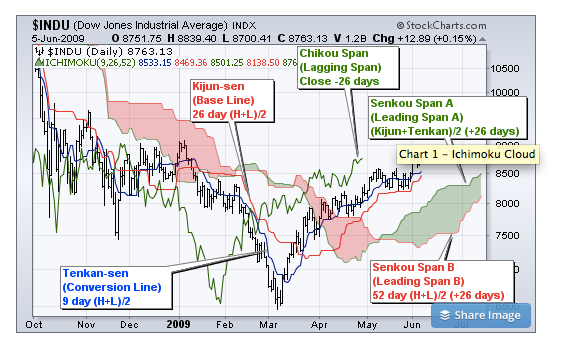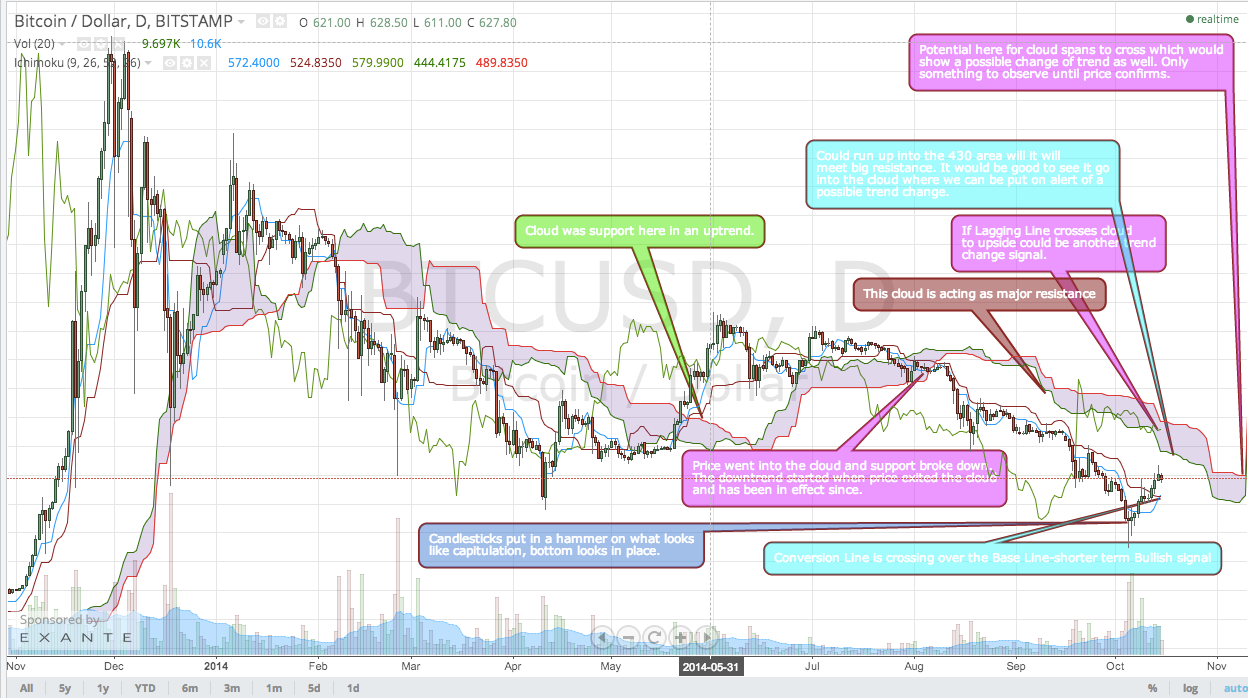If Asia is in fact the biggest market for trading Bitcoin, then it pays to look at technical indicators that the traders in this market are using.
In this piece we will be looking at Ichimoku Clouds, which is a very popular indicator and works particularly well with currencies and assets that track currencies.
Japanese candlesticks are another extremely popular indicator and can be used as a confirmation for Ichimoku Clouds. Tone Vays has talked extensively about candlesticks in previous articles so there is not need to go into details here.
Ichimoku Clouds are one of the more visual indicators which make them easy to interpret. It defines clearly support and resistance, identifies trend direction, gauges momentum, and provides trading signals. This can all be done with one look.
Components of the Cloud
There are 5 components to the cloud. The first one is Tenkan-Sen (i.e. Conversion Line). This line is constructed like a moving average. It looks back 9 days, but unlike a moving average you don’t average each day in the period.
You calculate the overall midpoint between the highest daily high and the lowest daily low in the period. This gives you the midpoint of the trading range across the last 9 days. Formula: (9 day high + 9 day low/2)).
The second line is Kijun-Sen (aka Base Line). This is calculated in the same way as the Conversion Line but has a look back period of 26 days. This was the original amount of Japanese trading days in 1 month. Formula: (26 day high +26 day low/2)). The Conversion Line is shorter than the Base Line so it turns more times than the Standard Line - these crossovers can be used much in the same as MA crossovers.
Senkou Span A (aka Leading Span A) is the midpoint between the Conversion Line and the Base Line. This forms one of the cloud boundaries. It is referred to as Leading because it’s plotted 26 days into the future and forms the “faster” cloud boundary. (Conversion Line + Base Line/2)).
Senkou Span B (aka Leading Span B) is the midpoint between the 52 day high and the 52 day low in price. Formula: (52 day high + 52 day low/2)). This is the equivalent of 2 trading months. This is also plotted 26 days into the future and forms the “slower” cloud boundary.
Please note that the spans are similar to 17 day (the midpoint of 9 and 26) and 52 day averages shifted forward. The Cloud is formed from a shorter term and a longer term average snaking around each other shifted ahead of price.
The final component is the Chikou Span (aka Lagging Span). This is simply the price close plotted 26 days in the past. Below is an example of how this looks:

How to interpret Ichimoku Clouds
The most important aspect of Ichimoku Clouds is how price intersects with the cloud. If the shorter term Span A is above the longer term Span B, prices are running up faster in the short term than they are in the long term.
This is bullish. Bullish signals become reinforced when the price is above the cloud. If shorter term Span A is below longer term Span B in the short term, prices are falling and this is bearish. Bearish signals are reinforced when the price is below the cloud.
If the price is in the cloud, this is a situation that needs to be resolved. What is important here is the direction from which you entered the cloud. If price comes into the cloud from above, this is still bullish and the cloud should act as support, if you price comes into the cloud from below, it’s still bearish and the cloud should act as resistance.
Regardless, once price enters the cloud this should be used as a warning signal of a potential change in trend. The question being asked by price is will the cloud provide support or resistance and transition into a new trend. It is important to note that clouds are often thicker at turning points especially if the change is dramatic.
If the Lagging Line crosses the cloud often price will follow as well and this is a true confirming signal that the trend has changed. Because it is lagging and slow moving, you are not subject to a lot of false signals with this.
Price crossing the cloud is a signal that can be traded on a shorter time scale as it is subject to false moves. Like mentioned above, until price makes a move into and out of the cloud, the old trend is still intact.
Cloud Span A and Cloud Span B crossing and the cloud changing direction ahead is a signal worth noting. It could bode well for a change in the trend but it is not recommended to trade on this signal.
The Conversion Line crossing the Standard Line can be read like moving averages crossovers and can be traded as such. These give much shorter term signals because crossovers are rather frequent.
Finally, it is worth noting that Ichimoku Clouds work best in trending markets. When a market has a long period of consolidation, this is not an indicator one should use. It has worked well with Bitcoin as seen in the chart below.

Conclusion
Bitcoin is still in a bearish trend. The price is below the clouds and is yet to test resistance above. It is a good time to watch for signals that could signal a change in trend. While things are improving short term, more evidence is needed before an intermediate term trend change is in effect.
About the author
George Samman is the co-founder and COO of BTC.sx, the world’s first Bitcoin-only trading platform. He is a former Wall Street Senior Portfolio Manager and Market Strategist as well as a technical analyst. He holds the Chartered Market Technician (CMT) designation. A seasoned trader, George has over ten years of experience in the financial markets.
